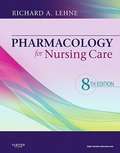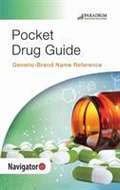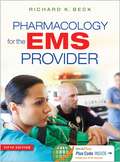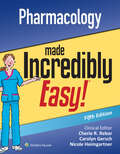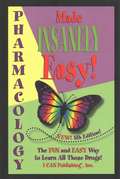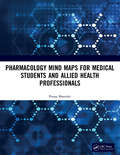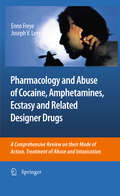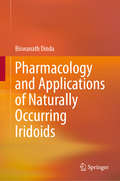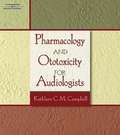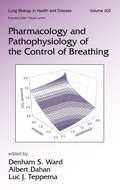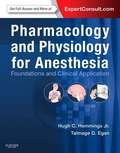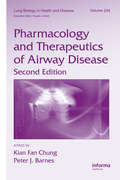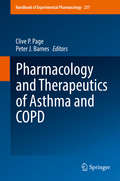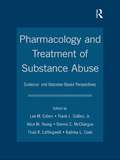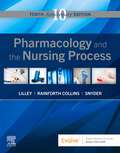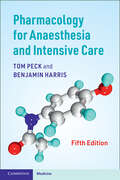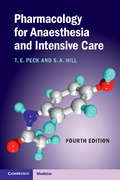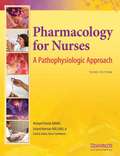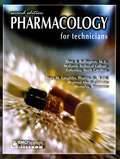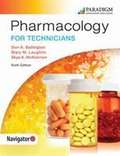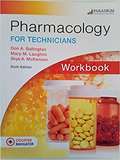- Table View
- List View
Pharmacology For Nursing Care
by Richard A. LehneA favorite among nursing students, Pharmacology for Nursing Care, 8th Edition, features a uniquely engaging writing style, clear explanations, and unmatched clinical precision and currency to help you gain a solid understanding of key drugs and their implications -- as opposed to just memorization of certain facts. Compelling features such as a drug prototype approach, use of large and small print to distinguish need-to-know versus nice-to-know content, and a focus on major nursing implications save you study time by directing your attention on the most important, need-to-know information. The new edition also features an abundance of content updates to keep you ahead of the curve in school and in professional practice. UNIQUE! Engaging writing style with clear explanations makes content easy to grasp and even enjoyable to learn. A drug prototype approach uses one drug within each drug family to characterize all members of its group to help you learn about related drugs currently on the market and drugs that will be released once you begin practice. UNIQUE! Special Interest Topic boxes address timely issues in pharmacology and connect pharmacology content with current trends. Large print/small print design distinguishes essential "need-to-know" information from "nice-to-know" information. Limited discussion of adverse effects and drug interactions keeps your limited study time focused on only the most clinically important information. Reliance on up-to-date evidence-based clinical guidelines ensures that therapeutic uses are clinically relevant. Integrated and summarized nursing content demonstrates the vital interplay between drug therapy and nursing care. Coverage of dietary supplements and herbal interactions equips you to alert patients and caregivers to the potential dangers of certain dietary supplements, including interactions with prescribed and over-the-counter drugs and herbal therapies. Additional learning features provide a touchstone for study and review as you complete reading assignments and build a foundation of pharmacologic knowledge. Updated drug content and related nursing content reflect the very latest FDA drug approvals, withdrawals, and evidence-based therapeutic uses. Expanded and updated content on medication safety prepares you to pass the NCLEX Examination and practice safe medication administration in the clinical setting. Expanded coverage of pharmacogenomics introduces you to the many different genetic factors that influence drug therapy
Pharmacology For Technicians: Paradigm's Pocket Drug Guide
by Don A. Ballington Mary M. Laughlin Skye McKennon<P>As the most in-depth pharmacology text designed specifically for pharmacy technicians, this title prepares students for a career in community, institutional, and other pharmacy settings.<P> Students will develop a basic understanding of drug classes and the mechanisms of action for many drugs. <P>They will also gain insight into why certain drugs are prescribed for particular disease states and obtain instruction for making informed, intelligent decisions when dispensing drugs.<P> Includes an all-new drug guide and workbook, available in print or digitally.
Pharmacology For The EMS Provider (Fifth Edition)
by Richard K. BeckDesigned for learning success. Overcome your fears and build your confidence while you master the mathematic and pharmacology knowledge you need to pass your licensure exams and prepare for professional practice. The 5th Edition of this popular resource presents often complex information is an way that's easy to understand and easy to follow, emphasizing the relevance of the drug information to your work as a paramedic as well as the calculations required to safely administer the correct drug dosages. Access more online. Redeem the Plus Code inside new, printed texts to access a wealth of resources online at DavisPlus. You'll find your Davis Digital Version, your complete text online, study questions, and fifteen animated learning modules that show you how drugs work. "Good book. " "This book is VERY helpful! I found that it breaks the math down and makes it very simple and easy to follow! I recommend this book to anyone going through Paramedic School!"--Kimberly Wright, review of a previous edition
Pharmacology Made Incredibly Easy (Incredibly Easy! Series®)
by Cherie R. Rebar Nicole M. Heimgartner Carolyn GerschReady to master the medication process? Tap into the go-to resource for nursing pharmacology basics, with the fully updated new fifth edition of Pharmacology Made Incredibly Easy!®.Offering clear, concise descriptions of crucial nursing pharmacology concepts and procedures, this easy-to-follow, colorfully illustrated guide offers step-by-step guidance so to can grasp the fundamentals in enjoyable Incredibly Easy style. From initial assessment to safe medication administration and patient care plans, this is the perfect supplement to class materials, offering solid preparation for NCLEX®, as well as a handy refresher for experienced nurses.
Pharmacology Made Insanely Easy!
by Loretta Manning Sylvia RayfieldThey bring you the book you've been “SCREAMING” for ... Pharmacology Made Insanely Easy! With over 1,150 drugs and alternative meds represented by only 245 images. Pharmacology Made Insanely Easy! will be an awesome learning tool utilizing the same GREAT methods you found in Nursing Made Insanely Easy! <P><P> The biggest difference is that this book will be useful for learners in pharmacology, pharmacy tech, medicine, physical therapy, physicians assistants, nurse practitioners, international nurses preparing for the CGFNS Qualifying Exam, nursing students of all medical and allied health programs or anyone needing a way to remember “all those drugs”. Carry this book with you throughout your career as a useful reference.
Pharmacology Mind Maps for Medical Students and Allied Health Professionals
by Prasan BhandariPharmacology Mind Maps is meant as a concise companion for the pharmacology students, enabling them to revise the subject in a short time through the innovative and effective technique of mind maps, after understanding the subject from a standard reference textbook. This handy manual provides the subject information in a condensed form, helping in last minute revision. Mind mapping is slowly taking over traditional methods and techniques and is explored extensively for a subject like pharmacology which is both an essential as well as a difficult subject to master for a medical student. This book will thus help the students to read, revise and recollect the subject easily and rapidly.
Pharmacology and Abuse of Cocaine, Amphetamines, Ecstasy and Related Designer Drugs
by Joseph V. Levy Enno FreyeFinally - a book that covers all aspects of the illicit use of cocaine, amphetamines, ecstasy and/or designer drugs such as GHB, written by two experts in their field. The use of these drugs remains a continuous threat in health and medical care delivery, and this book will be an essential asset to the physician who may have to face the evaluation of patients whose use of these drugs compromises an effective treatment plan for other health issues. The book has been conceived to fill the void in existing physician reference materials, and provides a comprehensive review of the theoretical knowledge and scope of pharmacotherapy in individuals who are hooked on a psychoactive substance. While detailed scientific information is obtainable in other major articles, the book's straightforward format and style, along with its illustrations, will make for easy reading as emphasis is put on information specifically related to drugs that occur most abused in today's society. The information provided is based on clinical practice rather than pure experimental data, which will give the physician more effective tools useful in their daily practice. Many mechanisms of action of abuse are described in detail and references are provided to direct the reader to further sources for additional information. As a special feature, the book incorporates uncluttered tables and charts, which result in immediate clarification of the mode of action on the central nervous system and the reason for misuse, thus avoiding usual long and fatiguing text in common reference books. The book aims to give the reader a clear and concise plan on what to do when being faced with an overdose situation. A well-organized Table of Contents rapidly leads the reader from general pharmacological issues to the specific overdose syndrome and its management. Additionally, significant emphasis is placed on the practical do's and don'ts for physicians, with special reference to the predictive signs of aberrant drug-related behavior and the identification of the drug diverter by using urine drug screening.
Pharmacology and Applications of Naturally Occurring Iridoids
by Biswanath DindaIn this book, the author provides expert analysis on naturally occurring iridoids, their chemistry and their distribution in plants and insects. Particular attention is given to the pharmacology of iridoids and their prospective applications in pharmaceutical and agricultural industries. Iridoids are found in a wide variety of plants and some insects, and they are structurally derived from monoterpenoid natural products. In the first two chapters of this book, the author describes the iridoids classification, occurrence and distribution in plants and insects. The following chapters cover different chromatographic and spectroscopic techniques that can be used to identify and quantify iridoids in herbal formulations, and also the biosynthesis of iridoids, in which the reader will discover a metabolomics and transcriptomics analysis to identify the genes involved in the biosynthesis. The final chapters provide insights on several pharmacological activities of iridoids, their physiological role in insects, pharmacokinetics in mammals, insects and microorganisms, and their applications in medicine and agriculture. This book will engage students and researchers interested in the chemistry of natural products, and it will also appeal to medicinal chemists and practitioners working in the design of new herbal drugs with bioactive pure iridoids.
Pharmacology and Ototoxicity for Audiologists
by Kathleen CampbellThis highly anticipated text is the only publication on pharmacology and ototoxicity written specifically for audiologists. With contributions from leading audiologists, basic scientists, pharmacologists, and otolaryngologists, Pharmacology and Ototoxicity for Audiologists provides both basic and advanced coverage of topics critical to successful clinical practice.
Pharmacology and Pathophysiology of the Control of Breathing (Lung Biology in Health and Disease)
by Albert Dahan Denham S. Ward Luc J. TeppemaExploring the functional anatomy and physiology of the ventilatory control system from the intracellular to the integrative level, this references serves as the first source to offer comprehensive coverage of the influences of various pharmacological agents on the control of breathing.
Pharmacology and Physiology for Anesthesia
by Hugh C. Hemmings Talmage D. EganBetter understand the complexities of pharmacology and physiology relevant to your practice with the brand-new medical reference book, Pharmacology and Physiology for Anesthesia. Drs. Hugh Hemmings and Talmage Egan provide the clinical insights you need to effectively administer anesthesia, ensuring patient safety and the most optimal outcomes. Access comprehensive, continually updated research on the physiology of organ systems and clinical topics in the pharmacology of anesthetic drugs. Quickly and easily reference the information you need through user-friendly tables, figures, and algorithms, all presented in lavish full color throughout. Understand the molecular mechanism of drug actions and identify key drug interactions that may complicate anesthesia with dedicated sections on these key areas. Search the text and download images online at Expert Consult. Build a thorough knowledge of pharmacology and physiology focused on clinical practice
Pharmacology and Therapeutics of Airway Disease
by Peter J. Barnes Kian Fan ChungWritten as a concise clinical reference guide covering the current and future airway disease treatments, this text encompasses: pathophysiology of respiratory tract diseasesthe methods of measuring airway and clinical responsesthe concepts upon which many treatments are used in COPD and asthma conditionsthe way in which these treatments work,
Pharmacology and Therapeutics of Asthma and COPD
by Clive P. Page Peter J. BarnesThe present volume is supposed to be a major reference resource for chest physicians and those involved in the development of novel pharmaceutical entities for these diseases. Internationally recognized authorities review the most important new information on the advances in our understanding of the pathogenesis and treatment of these diseases, including the substantial advances in the topical delivery of inhaled medicines. Each chapter is extensively referenced, generously illustrated with clear diagrams and photographs, and represents a state-of-the-art review of this important area of respiratory medicine.
Pharmacology and Treatment of Substance Abuse: Evidence and Outcome Based Perspectives (Counseling and Psychotherapy)
by Jr. Lee M. Cohen Frank L. Collins Alice M. Young Dennis E. McChargue Thad R. Leffingwell Katrina L. CookGiven the prevalence of substance abuse in general clinical populations, it is important for healthcare providers to have knowledge and skill in the treatment of these problems. Evidence-Based Practice (EBP) involves the integration of the best evidence with clinical expertise and patient values. This text is designed as a bridge for practitioners that will provide up-to-date evidence reviews as well as information on how to best keep up with emerging trends in the field. The editors have gathered expert authors to provide a much needed summary of the current status of the evidence based practice for both the assessment and treatment of specific substance use disorders.
Pharmacology and the Nursing Process
by Linda Lane Lilley Shelly Rainforth Collins Julie S. SnyderGain the pharmacology knowledge and skills you need to administer medications safely! Pharmacology and the Nursing Process, 10th Edition provides practical, easy-to-use pharmacology information, emphasizing the application of the nursing process and prioritization throughout the book. Coverage begins with pharmacology basics, then discusses drugs by body systems and drug functions. Hundreds of full-color illustrations show how drugs work in the body and depict key steps in medication administration. Written by pharmacology experts Linda Lane Lilley, Shelly Rainforth Collins, and Julie S. Snyder, this bestselling textbook makes it easy to understand and apply pharmacology concepts and provide safe, quality nursing care.
Pharmacology for Anaesthesia and Intensive Care
by Tom Peck Benjamin HarrisThe fifth edition of this popular textbook continues to provide a solid foundation of pharmacological knowledge for all those working in anaesthesia and intensive care. The content has been thoroughly revised to include expanded chapters with clearer figures, ensuring readers are kept abreast of the ever-changing landscape of clinical pharmacology. Conveniently divided into four sections covering the basic principles of pharmacology, core drugs in anaesthetic practice, cardiovascular drugs, and other important drugs and complemented by new diagrams, tables and chemical formulae to facilitate learning. All four chapters on core drugs in anaesthetic practice have been updated along with others exploring applied pharmacokinetic models, antimicrobials, and drugs used in diabetes. An ideal aid to study and practice for junior and trainee anaesthetists and intensive care specialists preparing for exams. Also an invaluable resource for theatre practitioners, ICU nurses and physicians working in areas that demand a solid knowledge of pharmacology.
Pharmacology for Anaesthesia and Intensive Care
by Tom Peck Sue Hill Mark Williams Tom Peck Sue HillThe third edition of this market leading book has been thoroughly updated and expanded, with additional contributions from experts in the field, to include all new drugs available to the anaesthetist and intensive care specialist. Basic pharmacological principles, vital to understanding how individual drugs actually have their effects, are dealt with methodically and with many highly annotated diagrams and tables. With hospital infections becoming increasingly prevalent, the important section on antibiotics has been further expanded. With the third edition, this well established title continues to provide its readers with the most concise yet comprehensive coverage of all aspects of pharmacology. An ideal aid to study and practice for junior and trainee anaesthetists, critical care nurses and all physicians and healthcare professionals working in theatre, accident and emergency departments or intensive care units.
Pharmacology for Anaesthesia and Intensive Care (4th Edition)
by T. E. Peck S. A. HillThe fourth edition of this market leading anaesthetic book has been fully updated to include novel oral anticoagulants and neuromuscular reversal agents. Numerous other sections have been expanded or updated to reflect new research and current best practice, and the antibiotics chapter now includes information about commonly encountered pathogens and the drugs used to target them. Basic pharmacological principles, vital to understanding the effects of individual drugs, are dealt with methodically, and the essential physiology is described alongside the relevant pharmacology. This has become the core pharmacology book for the FRCA, covering all the relevant kinetics and dynamics in a compact and easy to navigate format, including clear diagrams and tables. This is an ideal aid to study and practice for junior and trainee anaesthetists. Theatre practitioners, ICU nurses and physicians working in areas that demand a solid foundation of pharmacological knowledge will also find this an invaluable resource.
Pharmacology for Nurses: A Pathophysiologic Approach (3rd Edition)
by Michael Patrick Adams Leland Norman Holland Jr. Carol Q. UrbanThe third edition of Pharmacology for Nurses: A Pathophysiologic Approach has been thoroughly updated to reflect current pharmacologic drugs and processes. This book is structured to present pharmacology and pathology together, so students can more easily grasp the interrelationship between these subjects and patient care.
Pharmacology for Technicians (2nd edition)
by Don A. Ballington Mary M. LaughlinThis second edition offers updated discussion of drug actions and interactions, and expanded treatment of generic drugs, the drug approval process, and pharmacokinetics. Internet research exercises are also new to this edition. Ballington is program coordinator for the pharmacy technician training program at Midlands Technical College (Columbia, South Carolina); Laughlin is affiliated with the Regional Medical Center in Memphis, Tennessee and the U. of Tennessee.
Pharmacology for Technicians (6th Edition)
by Don A. Ballington Mary M. Laughlin Skye McKennonAs the most in-depth pharmacology text designed specifically for pharmacy technicians, this title prepares students for a career in community, institutional, and other pharmacy settings. Students will develop a basic understanding of drug classes and the mechanisms of action for many drugs. They will also gain insight into why certain drugs are prescribed for particular disease states and obtain instruction for making informed, intelligent decisions when dispensing drugs. Includes an all-new drug guide and workbook, available in print or digitally.
Pharmacology for Technicians (Second Edition)
by Don A. Ballington Mary M. LaughlinThis second edition offers updated discussion of drug actions and interactions, and expanded treatment of generic drugs, the drug approval process, and pharmacokinetics. Internet research exercises are also new to this edition. Ballington is program coordinator for the pharmacy technician training program at Midlands Technical College (Columbia, South Carolina); Laughlin is affiliated with the Regional Medical Center in Memphis, Tennessee and the U. of Tennessee.
Pharmacology for Technicians Workbook
by Don A. Ballington Mary M. LaughlinText introducing the action mechanisms of drugs and their dispensatory requirements. Basic pharmaceutical concepts and techniques are covered.
Pharmacology for Technicians: Workbook (6th Edition)
by Don A. Ballington Mary M. Laughlin Skye McKennonAs the most in-depth pharmacology text designed specifically for pharmacy technicians, this title prepares students for a career in community, institutional, and other pharmacy settings. Students will develop a basic understanding of drug classes and the mechanisms of action for many drugs. They will also gain insight into why certain drugs are prescribed for particular disease states and obtain instruction for making informed, intelligent decisions when dispensing drugs. Includes an all-new drug guide and workbook, available in print or digitally.
